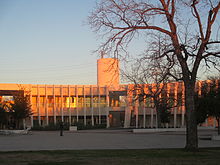According to the Nielsen Company, adults in Austin read and contribute to blogs more than those in any other U.S. metropolitan area.[102] Austin residents have the highest internet usage in all of Texas.[102] Austin was selected as the No. 2 Best Big City in "Best Places to Live" by Money magazine in 2006, and No. 3 in 2009, and also the "Greenest City in America" by MSN.[103][104] According to Travel & Leisure magazine, Austin ranks No. 1 on the list of cities with the best people, referring to the personalities and attributes of the citizens.[105] In 2012, the city was listed among the 10 best places to retire in the U.S. by CBS Money Watch.[106]
Recently in 2015, Forbes listed Austin as #1 Boom Town[107] because of its economic strength, including jobs among other appealing attributes.
South Congress is a shopping district stretching down South Congress Avenue from Downtown. This area is home to coffee shops, eccentric stores, restaurants, food trucks, trailers and festivals. It prides itself on "Keeping Austin Weird", especially with development in the surrounding area(s).
Old Austin
Old Austin is an adage often used by the native citizens in Austin, Texas when being nostalgic to refer to the olden days of the capital city of Texas.[108] Although Austin is also known internationally as the live music capital of the world and its catch phrase/slogan Keep Austin Weird can be heard echoed in places as far as Buffalo, NY and Santa Monica, CA - the term Old Austin refers to a time when the city was smaller and better known for its lack of traffic, hipsters, and urban sprawl.[109] It is often employed by longtime residents expressing displeasure at the rapidly changing culture.[110]
Construction barrier on South Congress with sentiment towards growth of the city.
Annual cultural events
See also: Category:Festivals in Austin, Texas
The sights of Austin's nightlife on 6th Street during 2012 South by Southwest
Rear photo of the Emma S. Barrientos Mexican American Cultural Center,
located on Lady Bird Lake at 600 River Street in Austin. The center
sponsors ethnic cultural events, including an annual celebration to the
memory of labor figure Cesar Chavez.
Other annual events include Eeyore's Birthday Party, Spamarama, Austin Gay Pride, the Austin Reggae Festival in April,[115] Kite Festival, Texas Craft Brewers Festival in September,[116] Art City Austin in April,[117] East Austin Studio Tour in November,[118] and Carnaval Brasileiro in February. Sixth Street features annual festivals such as the Pecan Street Festival and Halloween night. The three-day Austin City Limits Music Festival has been held in Zilker Park every year since 2002. Every year around the end of March and the beginning of April, Austin is home to "Texas Relay Weekend."
Austin's Zilker Park Tree is a Christmas display made of lights strung from the top of a Moonlight tower in Zilker Park. The Zilker Tree is lit in December along with the "Trail of Lights," an Austin Christmas tradition. The Trail of Lights were cancelled four times, first starting in 2001 and 2002 due to the September 11 Attacks, and again in 2010 and 2011 due to budget shortfalls, but the trail was turned back on for the 2012 holiday season.[119]
Music
Main article: Music of Austin
2009 Austin City Limits Music Festival with view of stages and Downtown Austin
The longest-running concert music program on American television, Austin City Limits, is recorded at ACL Live at The Moody Theater. Austin City Limits and C3 Presents produce the Austin City Limits Music Festival, an annual music and art festival held at Zilker Park in Austin. Other music events include the Urban Music Festival, Fun Fun Fun Fest, Chaos In Tejas and Old Settler's Music Festival. Austin Lyric Opera performs multiple operas each year (including the 2007 opening of Philip Glass's Waiting for the Barbarians, written by University of Texas at Austin alumnus J. M. Coetzee).[121] The Austin Symphony Orchestra performs a range of classical, pop and family performances and is led by Music Director and Conductor Peter Ba




No comments:
Post a Comment